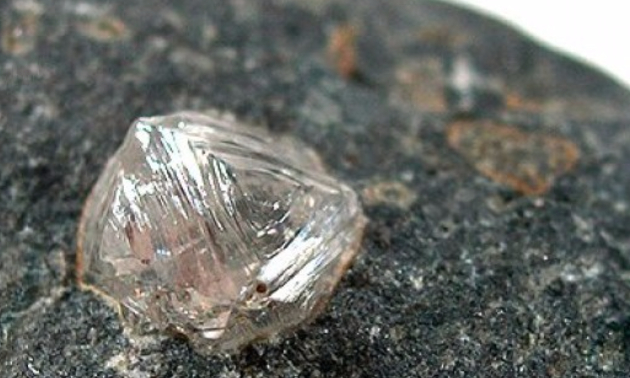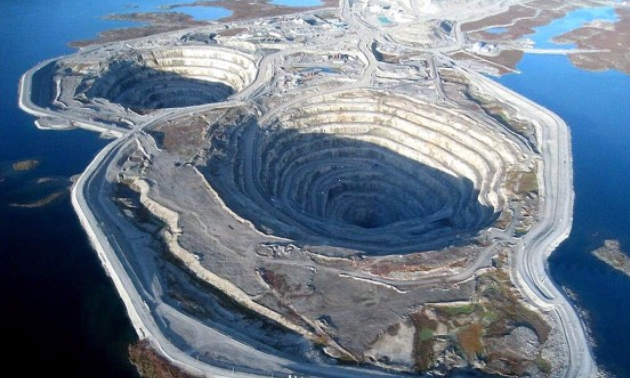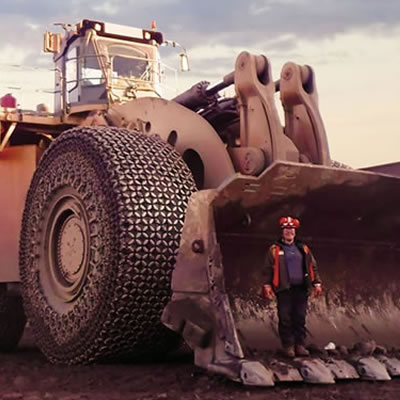Uranium explorer may have uncovered massive kimberlite field in the Athabasca Basin

Rough diamond — Photo courtesy of palisade-research
Sometimes mineral discoveries are made by chance. Recall Robert Friedland’s Diamond Fields? In the company’s search for diamonds in Labrador, Canada, they stumbled onto one of the country’s richest nickel-copper discoveries.
Voisey’s Bay was spotted from a helicopter by geologists who noticed a large rusty-colored outcrop. When Diamond Field’s sunk drills into the stained rock, the core they pulled out was a brilliant brass. Friedland eventually sold Voisey’s Bay to Inco for $4.5 billion. Not bad for a venture aimed at finding diamond prospects.
Like Labrador, northern Saskatchewan, is a fairly remote area – both have far more cariboo than residents. The province’s Athabasca basin however is well established with high-grade uranium; in fact the richest on the planet, with deposits typically grading 100 times greater than anywhere else.
The basin may yield another very valuable commodity: diamonds. At least that is the hope of several exploration companies that have recently staked claims in the northwest Athabasca. Fueling interest in the area is new recognition that the region is underlain by very old “Rae Craton” rocks, a similar geological setting that hosts the rich Ekati and Diavik diamond mines further north in the Northwest Territories.
Recent studies have gone a step further. In 2011, the Saskatchewan Geological Survey conducted an airborne magnetic survey to better understand the geology of northern Saskatchewan. Uranium explorer CanAlaska Uranium Ltd. (TSXV: CVV), that has property interests throughout the Athabasca, took a hard look at the government data. They were stunned by what they saw.
The survey clearly revealed a series of discrete, circular, magnetic anomalies. Furthermore, they occurred in clusters and had shallow signatures. In addition to the right geological setting (old rocks and thick crust/lithosphere), kimberlite indicator minerals had been discovered downstream, with an unknown source. It became apparent to CanAlaska’s technical team that they were probably looking at kimberlites.
CanAlaska staked claims covering the best “bulls-eye” anomalies revealed by their interpretation of the government data – initially about 20,000 hectares. As uranium explorers, CanAlaska wasn’t in a rush to publicize its findings, especially with the resource market deep in bear territory. The data and opportunity however were too compelling not to pursue, and more claims were acquired in early 2016.
The market barely reacted in February when CanAlaska announced it had staked 75 kimberlite targets. However a couple of mining entrepreneurs involved in Canada’s first big diamond rush took notice. Richard Atkinson and Victor Tanaka, directors of Fjordland Exploration (TSXV: FEX) quietly staked ground completely surrounding CanAlaska’s claims. The claims apparently were initially acquired in Vic Tanaka’s name to minimize tipping-off competitors.
Tanaka, a professional geologist, cut his teeth with diamonds working with geologist Gren Thomas at Aber Resources (now Dominion Diamond Corporation). Aber was a small exploration outfit that were one of the first to stake claims in the Lac de Gras area in 1991. The following year Aber found eight kimberlites which led to discovery of high-grade diamonds at Diavik. The Diavik mine is one of the largest diamond mines in the world.

Aerial view of Diavik mine. — Photo courtesy of palisade-research
CanAlaska’s Athabasca play grabbed the market’s attention when the junior announced on May 18, 2016, a major partner for its Athabasca Kimberlite project. De Beers, the world’s leading diamond company, signed a $20.4 million deal to hunt diamonds in the basin. To attract De Beers was quite a coup for CanAlaska as it validated the regions’ prospectively for diamonds.
The deal essentially enables De Beers to explore CanAlaska’s targets through a series of staged work programs. CanAlaska can convert the deal into a joint venture once De Beers reaches 70% interest in the project. In the meantime CanAlaska can learn from De Beers to explore its other kimberlite prospects elsewhere in the region.
De Beers should start their exploration program this summer. Airborne surveys and ground sampling for indicator minerals will define drill targets. Thereafter drilling on the better targets is expected, likely in early winter which is the best time to drill given the many bodies of water in the region.
A staking rush is underway as companies jockey for remaining ground. By this time next year, exploration by De Beers and new players, may have ushered in Canada’s next diamond boom. Investors will be watching to see if the basin has some sparkle.
Palisade Global Investments Disclaimer:
The views and opinions expressed in this article are those of the authors, and do not represent the views of Palisade Global Investments Ltd. Readers should not consider statements made by the author as formal recommendations and should consult their financial advisor before making any investment decisions.




